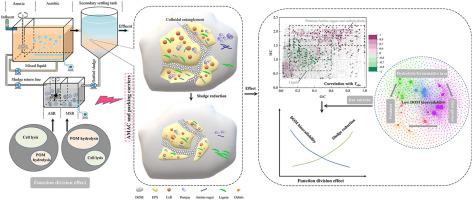Journal of Cleaner Production ( IF 9.7 ) Pub Date : 2021-05-04 , DOI: 10.1016/j.jclepro.2021.127192 Cheng Cheng , Jinju Geng , Zhen Zhou , Qingmiao Yu , Rongwei Gao , Yihan Shi , Liye Wang , Hongqiang Ren

|
Activated sludge process with anaerobic side-stream reactors (SR) in the sludge recirculation line can achieve in-situ sludge reduction. But sludge reduction efficiency (SRE) is limited with low cell lysis and particle organic matter hydrolysis rates under short hydraulic retention time of SR for practical application. This study firstly inserted alternating micro-aerobic/anaerobic conditions (AMAC) and packing carriers into SR with low hydraulic retention time for improving SRE. The effects of AMAC and packing carriers on sludge rheology properties, molecular characteristics of dissolved organic matter (DOM) and microbial communities were investigated. Results showed that AMAC coupled packing carriers achieved SRE by 51.09% with efficient effluent pollutant removal. AMAC specialized inactive particle organic matter hydrolysis and active cell lysis in the micro-aerobic and anaerobic SR, respectively. Packing carriers intensified this function division effect. This effect weakened colloidal entanglement of flocs. It intensified the cell lysis in mainstream aerobic tank, causing the accumulation of refractory lignins in DOM. The higher utilization of released bioavailable DOM decreased microbial activity. Overall, the improved SRE favored the declined DOM bioavailability by inserting AMAC and packing carriers in SR. The sludge reduction-related bacteria like slow growing (Dechloromonas), predatory (Norank_Saprospiraceae), and hydrolytic/fermentative bacteria (Chelatococcus, Pseudomonas, Tolumonas, and Unclassified_Bacteroidia) were involved in decreasing DOM bioavailability. This study advanced our knowledge about the effects of AMAC and packing carriers on in-situ sludge reduction systems. This research also showed how AMAC and packing carriers enhanced the sludge lysis/hydrolysis for sludge reduction.
中文翻译:

一种新颖的缺氧/好氧工艺,再加上装有填料载体的微需氧/厌氧侧流反应器,以原位减少污泥
在污泥再循环管线中使用厌氧侧流反应器(SR)进行活性污泥工艺可实现原位减少污泥。但是,在实际应用中,在短时间的SR水力停留时间下,低细胞裂解和颗粒有机物的水解速率会限制污泥的降低效率(SRE)。这项研究首先将交替的微好氧/厌氧条件(AMAC)插入并以低水力停留时间将载体包装到SR中,以改善SRE。研究了AMAC和填料载体对污泥流变特性,溶解性有机物(DOM)的分子特性和微生物群落的影响。结果表明,AMAC偶联填料载体可有效去除废水中的污染物,实现SRE的51.09%。AMAC在微好氧和厌氧SR中分别进行了非活性颗粒有机物的水解和活性细胞的裂解。包装载体增强了这种功能划分效果。这种作用减弱了絮体的胶体缠结。它加剧了主流需氧罐中的细胞裂解,导致难降解木质素在DOM中积累。释放的生物可利用的DOM的更高利用率降低了微生物活性。总体而言,改进的SRE通过在SR中插入AMAC和包装载体来支持DOM生物利用度下降。与污泥减少有关的细菌,例如生长缓慢(Dechloromonas),捕食性(Norank_Saprospiraceae)和水解/发酵细菌(Chelatococcus,Pseudomonas,Tolumonas和Unclassified_Bacteroidia)参与了DOM生物利用率的降低。这项研究提高了我们对AMAC和填料载体对原位污泥减少系统的影响的认识。这项研究还表明,AMAC和填料载体如何增强污泥裂解/水解以减少污泥。





















































 京公网安备 11010802027423号
京公网安备 11010802027423号